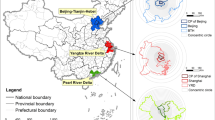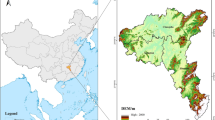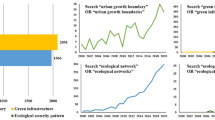Abstract
Rapid urbanization is profoundly impacting the ecological environment and landscape patterns, leading to a decline in ecosystem services (ES) and posing threats to both ecological security and human well-being. This study aimed to identify the spatial and temporal patterns of ecosystem service bundles (ESB) in the Beibu Gulf urban agglomeration from 2000 to 2030, analyze the trajectory of ESB evolution, and elucidate the drivers behind ESB formation and evolution. We utilized the Patch-generating Land Use Simulation (PLUS) model to establish baseline (BLS), carbon sequestration priority (CPS), and urbanization priority (UPS) scenarios for simulating land use patterns in 2030. Following the assessment of ecosystem service values (ESV) through the equivalent factor method, we identified the spatiotemporal distribution patterns of ESB using the K-means clustering algorithm. By employing stability mapping and landscape indices, we identified and analyzed various types of ESB evolutionary trajectories. Redundancy analysis (RDA) was employed to pinpoint the drivers of ESB formation and evolution. The results revealed that from 2000 to 2030, land use changes were primarily observed in cropland, forestland, and construction land. Between 2000 and 2020, 92.88% of the region did not experience shifts in ESB types. In UPS, the ESB pattern in the study area underwent significant changes, with only 76.68% of the region exhibiting stabilized trajectories, while the other two scenarios recorded percentages higher than 80%. Key drivers of ESB-type shifts included initial food provision services, elevation, slope, changes in the proportion of construction land, and population change. This multi-scenario simulation of ESB evolution due to land use changes aids in comprehending potential future development directions from diverse perspectives and serves as a valuable reference for formulating and changing ecological management policies and strategies.










Similar content being viewed by others
Data availability
No datasets were generated or analyzed during the current study.
References
Alamgir, M., Turton, S. M., Macgregor, C. J., & Pert, P. L. (2016). Ecosystem services capacity across heterogeneous forest types: Understanding the interactions and suggesting pathways for sustaining multiple ecosystem services. Science of the Total Environment, 566, 584–595. https://doi.org/10.1016/j.scitotenv.2016.05.107
Balzan, M. V., Caruana, J., & Zammit, A. (2018). Assessing the capacity and flow of ecosystem services in multifunctional landscapes: Evidence of a rural-urban gradient in a Mediterranean small island state. Land Use Policy, 75, 711–725. https://doi.org/10.1016/j.landusepol.2017.08.025
Bennett, E. M., Peterson, G. D., & Gordon, L. J. (2009). Understanding relationships among multiple ecosystem services. Ecology Letters, 12, 1394–1404. https://doi.org/10.1111/j.1461-0248.2009.01387.x
Bommarco, R., Kleijn, D., & Potts, S. G. (2013). Ecological intensification: Harnessing ecosystem services for food security. Trends in Ecology & Evolution, 28, 230–238. https://doi.org/10.1016/j.tree.2012.10.012
Cao, Y., Li, G., Tian, Y., Fang, X., Li, Y., & Tan, Y. (2020). Linking ecosystem services trade-offs, bundles and hotspot identification with cropland management in the coastal Hangzhou Bay area of China. Land Use Policy, 97, 104689. https://doi.org/10.1016/j.landusepol.2020.104689
Castro, A. J., Verburg, P. H., Martin-Lopez, B., et al. (2014). Ecosystem service trade-offs from supply to social demand: A landscape-scale spatial analysis. Landscape and Urban Planning, 132, 102–110. https://doi.org/10.1016/j.landurbplan.2014.08.009
Chan, K. M. A., Satterfield, T., & Goldstein, J. (2012). Rethinking ecosystem services to better address and navigate cultural values. Ecological Economics, 74, 8–18. https://doi.org/10.1016/j.ecolecon.2011.11.011
Chen, H., Tang, L., Qiu, Q., Wang, B., & Hu, W. (2020). Spatial trade-offs and temporal evolution of multiple ecosystem services in a marine-terrestrial urban-agglomeration zone. International Journal of Environmental Research and Public Health, 17, 1231. https://doi.org/10.3390/ijerph17041231
Chen, S., Liu, X., Yang, L., & Zhu, Z. (2023). Variations in ecosystem service value and its driving factors in the Nanjing Metropolitan area of China. Forests, 14, 113. https://doi.org/10.3390/f14010113
Chen, W., & Chi, G. (2023). Ecosystem services trade-offs and synergies in China, 2000–2015. International Journal of Environmental Science and Technology, 20, 3221–3236. https://doi.org/10.1007/s13762-022-04141-8
Clough, Y., Krishna, V. V., Corre, M. D., et al. (2016). Land-use choices follow profitability at the expense of ecological functions in Indonesian smallholder landscapes. Nature Communications, 7, 13137. https://doi.org/10.1038/ncomms13137
Costanza, R., dArge R, deGroot R, et al. (1997). The value of the world’s ecosystem services and natural capital. Nature, 387, 253–260. https://doi.org/10.1038/387253a0
Dai, X., Wang, L., Yang, L., Wang, S., Li, Y., & Wang, L. (2022). Predicting the supply-demand of ecosystem services in the Yangtze River middle reaches urban agglomeration. Progress in Physical Geography-Earth and Environment, 46, 530–546. https://doi.org/10.1177/03091333221074490
Dittrich, A., Seppelt, R., Vaclavik, T., & Cord, A. F. (2017). Integrating ecosystem service bundles and socio-environmental conditions - A national scale analysis from Germany. Ecosystem Services, 28, 273–282. https://doi.org/10.1016/j.ecoser.2017.08.007
Feng Z, Peng J, Wu J (2020) Ecosystem service bundles based approach to exploring the trajectories of ecosystem service spatiotemporal change: A case study of Shenzhen City. Acta Ecologica Sinica 40:2545–2554. (in Chinese). https://doi.org/10.5846/stxb201903210530
Feng, Z., Wu, J., Gao, Y., & Peng, J. (2015). Environmental policy simulation and assessment under rapid urbanization: Case study of essential area policy in Shenzhen, China. Journal of Urban Planning and Development, 141, 05014030. https://doi.org/10.1061/(asce)up.1943-5444.0000259
Fisher, J. C., Bicknell, J. E., Irvine, K. N., Fernandes, D., Mistry, J., & Davies, Z. G. (2021). Exploring how urban nature is associated with human wellbeing in a neotropical city. Landscape and Urban Planning, 212, 104119. https://doi.org/10.1016/j.landurbplan.2021.104119
Gong, J., Jin, T., Liu, D., Zhu, Y., & Yan, L. (2022). Are ecosystem service bundles useful for mountainous landscape function zoning and management? A case study of Bailongjiang watershed in western China. Ecological Indicators, 134, 108495. https://doi.org/10.1016/j.ecolind.2021.108495
Guo, H., Cai, Y., Li, B., et al. (2022). An integrated modeling approach for ecological risks assessment under multiple scenarios in Guangzhou. China. Ecological Indicators, 142, 109270. https://doi.org/10.1016/j.ecolind.2022.109270
Han, S., Jing, Y., & Liu, Y. (2023). Simulation of land use landscape pattern evolution from a multi-scenario simulation: A case study of Nansi Lake Basin in China. Environmental Monitoring and Assessment, 195, 830. https://doi.org/10.1007/s10661-023-11416-1
Hasan, S. S., Zhen, L., Miah, M. G., Ahamed, T., & Samie, A. (2020). Impact of land use change on ecosystem services: A review. Environmental Development, 34, 100527. https://doi.org/10.1016/j.envdev.2020.100527
Himes, A., Puettmann, K., & Muraca, B. (2020). Trade-offs between ecosystem services along gradients of tree species diversity and values. Ecosystem Services, 44, 101133. https://doi.org/10.1016/j.ecoser.2020.101133
Huang, L., He, C., & Wang, B. (2022). Study on the spatial changes concerning ecosystem services value in Lhasa River Basin, China. Environmental Science and Pollution Research, 29, 7827–7843. https://doi.org/10.1007/s11356-021-16245-8
Ikotun, A. M., Ezugwu, A. E., Abualigah, L., Abuhaija, B., & Heming, J. (2023). K-means clustering algorithms: A comprehensive review, variants analysis, and advances in the era of big data. Information Sciences, 622, 178–210. https://doi.org/10.1016/j.ins.2022.11.139
Jantz, C. A., Goetz, S. J., Donato, D., & Claggett, P. (2010). Designing and implementing a regional urban modeling system using the SLEUTH cellular urban model. Computers Environment and Urban Systems, 34, 1–16. https://doi.org/10.1016/j.compenvurbsys.2009.08.003
Jiang H, Qin M, Wang Z, Luo D, Wu X (2023) Identification of priority areas for ecological restoration based on evaluation of ecosystem service bundles: Taking Changsha City as an example. Journal of Environmental Engineering Technology 13:1325–1333. (in Chinese). https://doi.org/10.12153/j.issn.1674-991X.20220983
Kareiva, P., Watts, S., McDonald, R., & Boucher, T. (2007). Domesticated nature: Shaping landscapes and ecosystems for human welfare. Science, 316, 1866–1869. https://doi.org/10.1126/science.1140170
Karimi, J. D., Corstanje, R., & Harris, J. A. (2021). Bundling ecosystem services at a high resolution in the UK: Trade-offs and synergies in urban landscapes. Landscape Ecology, 36, 1817–1835. https://doi.org/10.1007/s10980-021-01252-4
Liang, X., Guan, Q., Clarke, K. C., Chen, G., Guo, S., & Yao, Y. (2021a). Mixed-cell cellular automata: A new approach for simulating the spatio-temporal dynamics of mixed land use structures. Landscape and Urban Planning, 205, 103960. https://doi.org/10.1016/j.landurbplan.2020.103960
Liang, X., Guan, Q., Clarke, K. C., Liu, S., Wang, B., & Yao, Y. (2021b). Understanding the drivers of sustainable land expansion using a patch-generating land use simulation (PLUS) model: A case study in Wuhan. China. Computers Environment and Urban Systems, 85, 101569. https://doi.org/10.1016/j.compenvurbsys.2020.101569
Liang, X., Liu, X., Li, D., Zhao, H., & Chen, G. (2018). Urban growth simulation by incorporating planning policies into a CA-based future land-use simulation model. International Journal of Geographical Information Science, 32, 2294–2316. https://doi.org/10.1080/13658816.2018.1502441
Lin, G., Jiang, D., Fu, J., Cao, C., & Zhang, D. (2020). Spatial conflict of production-living-ecological space and sustainable-development scenario simulation in Yangtze River Delta agglomerations. Sustainability, 12, 2175. https://doi.org/10.3390/su12062175
Liu, H., Zheng, L., Wu, J., & Liao, Y. (2020a). Past and future ecosystem service trade-offs in Poyang Lake Basin under different land use policy scenarios. Arabian Journal of Geosciences, 13, 46. https://doi.org/10.1007/s12517-019-5004-x
Liu, W., Zhan, J., Zhao, F., Yan, H., Zhang, F., & Wei, X. (2019). Impacts of urbanization-induced land-use changes on ecosystem services: A case study of the Pearl River Delta Metropolitan Region, China. Ecological Indicators, 98, 228–238. https://doi.org/10.1016/j.ecolind.2018.10.054
Liu, X., Liang, X., Li, X., et al. (2017). A future land use simulation model (FLUS) for simulating multiple land use scenarios by coupling human and natural effects. Landscape and Urban Planning, 168, 94–116. https://doi.org/10.1016/j.landurbplan.2017.09.019
Liu, Y., Hou, X., Li, X., Song, B., & Wang, C. (2020b). Assessing and predicting changes in ecosystem service values based on land use/cover change in the Bohai Rim coastal zone. Ecological Indicators, 111, 106004. https://doi.org/10.1016/j.ecolind.2019.106004
Liu, Z., Huang, Q., Zhou, Y., & Sun, X. (2022). Spatial identification of restored priority areas based on ecosystem service bundles and urbanization effects in a megalopolis area. Journal of Environmental Management, 308, 114627. https://doi.org/10.1016/j.jenvman.2022.114627
Lyu, R., Clarke, K. C., Zhang, J., Feng, J., Jia, X., & Li, J. (2019). Spatial correlations among ecosystem services and their socio-ecological driving factors: A case study in the city belt along the Yellow River in Ningxia, China. Applied Geography, 108, 64–73. https://doi.org/10.1016/j.apgeog.2019.05.003
Madrigal-Martinez, S., Luis Miralles, I., & Garcia, J. (2020). Assessment method and scale of observation influence ecosystem service bundles. Land, 9, 392. https://doi.org/10.3390/land9100392
Millennium Ecosystem Assessment. (2005). Ecosystems and human well-being: Synthesis. Island Press.
Mitchell, M. G. E., Schuster, R., Jacob, A. L., et al. (2021). Identifying key ecosystem service providing areas to inform national-scale conservation planning. Environmental Research Letters, 16, 014038. https://doi.org/10.1088/1748-9326/abc121
Nassl, M., & Loeffler, J. (2015). Ecosystem services in coupled social-ecological systems: Closing the cycle of service provision and societal feedback. Ambio, 44, 737–749. https://doi.org/10.1007/s13280-015-0651-y
Nie, W., Bin, Xu. B., Yang, F., et al. (2023). Simulating future land use by coupling ecological security patterns and multiple scenarios. Science of the Total Environment, 859, 160262. https://doi.org/10.1016/j.scitotenv.2022.160262
Pan Y, Zheng H, Yi Q, Li R (2021) The change and driving factors of ecosystem service bundles: A case study of Daqing River Basin. Acta Ecologica Sinica 41:5204–5213. (in Chinese). https://doi.org/10.5846/stxb202103100650
Peng, J., Liu, Y., Corstanje, R., & Meersmans, J. (2021a). Promoting sustainable landscape pattern for landscape sustainability. Landscape Ecology, 36, 1839–1844. https://doi.org/10.1007/s10980-021-01271-1
Peng L, Deng W, Huang P, Liu Y (2021b) Evaluation of multiple ecosystem services landscape index and identification of ecosystem services bundles in Sichuan Basin. Acta Ecologica Sinica 41:9328–9340. (in Chinese). https://doi.org/10.5846/stxb202009062319
Qin, M., Zhao, Y., Liu, Y., Jiang, H., Li, H., & Zhu, Z. (2023). Multi-scenario simulation for 2060 and driving factors of the eco-spatial carbon sink in the Beibu Gulf urban agglomeration, China. Chinese Geographical Science, 33, 85–101. https://doi.org/10.1007/s11769-023-1327-3
Quintas-Soriano, C., Garcia-Llorente, M., Norstrom, A., Meacham, M., Peterson, G., & Castro, A. J. (2019). Integrating supply and demand in ecosystem service bundles characterization across Mediterranean transformed landscapes. Landscape Ecology, 34, 1619–1633. https://doi.org/10.1007/s10980-019-00826-7
Raudsepp-Hearne, C., Peterson, G. D., & Bennett, E. M. (2010). Ecosystem service bundles for analyzing tradeoffs in diverse landscapes. Proceedings of the National Academy of Sciences of the United States of America, 107, 5242–5247. https://doi.org/10.1073/pnas.0907284107
Renard, D., Rhemtulla, J. M., & Bennett, E. M. (2015). Historical dynamics in ecosystem service bundles. Proceedings of the National Academy of Sciences of the United States of America, 112, 13411–13416. https://doi.org/10.1073/pnas.1502565112
Riechers, M., Barkmann, J., & Tscharntke, T. (2018). Diverging perceptions by social groups on cultural ecosystem services provided by urban green. Landscape and Urban Planning, 175, 161–168. https://doi.org/10.1016/j.landurbplan.2018.03.017
Shen, J., Li, S., Liu, L., et al. (2021). Uncovering the relationships between ecosystem services and social-ecological drivers at different spatial scales in the Beijing-Tianjin- Hebei region. Journal of Cleaner Production, 290, 125193. https://doi.org/10.1016/j.jclepro.2020.125193
Shen, J., Li, S., Wang, H., et al. (2023). Understanding the spatial relationships and drivers of ecosystem service supply-demand mismatches towards spatially-targeted management of social-ecological system. Journal of Cleaner Production, 406, 136882. https://doi.org/10.1016/j.jclepro.2023.136882
Swetnam, R. D. (2007). Rural land use in England and Wales between 1930 and 1998: Mapping trajectories of change with a high resolution spatio-temporal dataset. Landscape and Urban Planning, 81, 91–103. https://doi.org/10.1016/j.landurbplan.2006.10.013
Taylor, L., Hahs, A. K., & Hochuli, D. F. (2018). Wellbeing and urban living: Nurtured by nature. Urban Ecosystems, 21, 1227–1228. https://doi.org/10.1007/s11252-018-0788-0
Van der Biest, K., D’Hondt, R., Jacobs, S., et al. (2014). EBI: An index for delivery of ecosystem service bundles. Ecological Indicators, 37, 252–265. https://doi.org/10.1016/j.ecolind.2013.04.006
Wang, B., & Luo, L. (2022). Service value of a bay city ecosystem based on green buildings and landscape pattern changes. Sustainable Computing-Informatics & Systems, 35, 100758. https://doi.org/10.1016/j.suscom.2022.100758
Xie G, Zhang C, Zhang L, Chen W, Li S (2015) Improvement of the evaluation method for ecosystem service value based on per unit area. Journal of Natural Resources 30:1243–1254. (in Chinese). https://doi.org/10.11849/zrzyxb.2015.08.001
Xie, Z., Li, X., Chi, Y., et al. (2021). Ecosystem service value decreases more rapidly under the dual pressures of land use change and ecological vulnerability: A case study in Zhujiajian Island. Ocean & Coastal Management, 201, 105493. https://doi.org/10.1016/j.ocecoaman.2020.105493
Xu, J., Wang, S., Xiao, Y., et al. (2021). Mapping the spatiotemporal heterogeneity of ecosystem service relationships and bundles in Ningxia. China. Journal of Cleaner Production, 294, 126216. https://doi.org/10.1016/j.jclepro.2021.126216
Xue, X., Chen, Z., Wang, S., Feng, Z., Duan, Y., & Zhou, Z. (2022). Value entropy: A systematic evaluation mode of service ecosystem evolution. IEEE Transactions on Services Computing, 15, 1760–1773. https://doi.org/10.1109/tsc.2020.3016660
Zhang, C., Bai, Y., Yang, X., Gao, Z., Liang, J., & Chen, Z. (2022a). Scenario analysis of the relationship among ecosystem service values-A case study of Yinchuan Plain in northwestern China. Ecological Indicators, 143, 109320. https://doi.org/10.1016/j.ecolind.2022.109320
Zhang, J., He, C., Huang, Q., Li, J., & Qi, T. (2022b). Evaluating the supply and demand of cultural ecosystem services in the Tibetan Plateau of China. Landscape Ecology, 37, 2131–2148. https://doi.org/10.1007/s10980-022-01467-z
Zhang K, Chen J, Hou J, Zhou G, You H, Han X (2022c) Study on sustainable development of carbon storage in Guilin coupled with InVEST and GeoSOS-FLUS model. China Environmental Science 42:2799–2809. (in Chinese). https://doi.org/10.19674/j.cnki.issn1000-6923.20220216.004
Zhang, Z., Peng, J., Xu, Z., Wang, X., & Meersmans, J. (2021). Ecosystem services supply and demand response to urbanization: A case study of the Pearl River Delta. China. Ecosystem Services, 49, 101274. https://doi.org/10.1016/j.ecoser.2021.101274
Zhao, X., He, Y., Yu, C., Xu, D., & Zou, W. (2019). Assessment of ecosystem services value in a National Park Pilot. Sustainability, 11, 6609. https://doi.org/10.3390/su11236609
Zheng, F., & Hu, Y. (2018). Assessing temporal-spatial land use simulation effects with CLUE-S and Markov-CA models in Beijing. Environmental Science and Pollution Research, 25, 32231–32245. https://doi.org/10.1007/s11356-018-3189-2
Zheng, X., Zhao, L., Xiang, W., Li, N., Lv, L., & Yang, X. (2012). A coupled model for simulating spatio-temporal dynamics of land-use change: A case study in Changqing, Jinan, China. Landscape and Urban Planning, 106, 51–61. https://doi.org/10.1016/j.landurbplan.2012.02.006
Funding
This paper was supported by the National Natural Science Foundation of China (52268008).
Author information
Authors and Affiliations
Contributions
Hongbo Jiang: data curation, formal analysis, methodology, software, writing—original draft, review and editing. Menglin Qin: conceptualization, funding acquisition, supervision. Xinyu Wu: data curation, investigation, visualization, writing—review and editing. Dingding Luo: formal analysis. Huiting Ouyang: investigation, resources. Yuting Liu: validation.
Corresponding author
Ethics declarations
Ethics approval
Not applicable.
Consent to participate
Not applicable.
Consent for publication
Not applicable.
Competing interests
The authors declare no competing interests.
Additional information
Publisher's Note
Springer Nature remains neutral with regard to jurisdictional claims in published maps and institutional affiliations.
Rights and permissions
Springer Nature or its licensor (e.g. a society or other partner) holds exclusive rights to this article under a publishing agreement with the author(s) or other rightsholder(s); author self-archiving of the accepted manuscript version of this article is solely governed by the terms of such publishing agreement and applicable law.
About this article
Cite this article
Jiang, H., Qin, M., Wu, X. et al. Spatiotemporal evolution and driving factors of ecosystem service bundle based on multi-scenario simulation in Beibu Gulf urban agglomeration, China. Environ Monit Assess 196, 542 (2024). https://doi.org/10.1007/s10661-024-12663-6
Received:
Accepted:
Published:
DOI: https://doi.org/10.1007/s10661-024-12663-6




